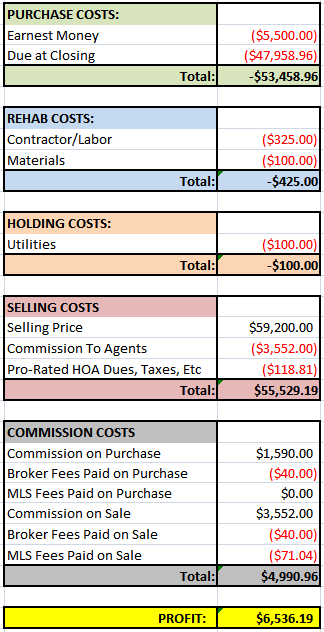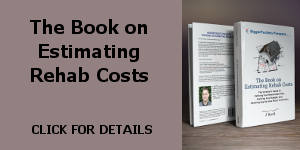I mentioned the other day that we had The Easy House under contract as a wholesale deal, and we’re already closed…
As part of the wholesale deal, we did some very minor repair work to ensure the property was in working order — we tested the plumbing, replaced the leaking supply valves on both the hot/cold washer lines, replaced a leaking toilet, had our HVAC company check and perform routine maintenance on the HVAC system and replaced a broken handle on the sliding glass door. About $400 worth of labor and materials and just a couple hours of work.
We made a little bit more than expected on this one just because the buyer didn’t have an agent, so we didn’t have to pay any commissions — and given that we only owned the property for 2 weeks, the ROI was great.
Here is the full final analysis for this one…
Timelines
Here are the key timeline milestones:
- Purchase Offer Date: 1/12/2012
- Purchase Closing Date: 2/23/2012
- Rehab Completion Date: 2/24/2012
- Sale Listing Date: 2/24/2012
- First Sale Contract Date: 3/4/2012
- Final Sale Contract Date: 3/4/2012
- Sale Closing Date: 3/9/2012
Financials
Here is the breakdown of financials for this project:

Our profit on this one was about $6,500, which is decent for a wholesale deal that we only held for two weeks. I wouldn’t have been upset to have held this one, rehabbed it and resold it to a retail buyer, but I’m also happy to get the cash out and move on to the next deal.
Final Statistics
Here are just some of the final statistics that I’ve been tracking for all my projects, and that summarize the success/failure of each project pretty well:
- From Offer to Purchase Time: 42 Days
- Rehab Time: 1 Days
- Selling Days on Market: 9 Days
- Selling Close Time: 5 Days
- Total Hold Time (Close to Close): 15 Days
- Total Profit: $6,536.19
- Return on Investment (ROI): 12.47%
- Annualized ROI: 303.33%




Congrats! I was looking at your spread sheet and numbers on this one and it just looked so weirdly familiar. I went to my analysis sheet for a wholesale deal I have closing next Friday. I’m using your spread sheet now, so it really does look the same in terms of format, font and colors. My projected profit number, including all purchase, resale, lender and holding costs (except the refunds on insurance and utilities) is $6,469.72. My holding time will be 40 days though.
And my ROI? How do you figure ROI again…..when you have no money out of pocket? 🙂 I have lender funds with six month terms and it’s not secured by any particular property. This is my second deal with those funds and it’s been four months…want to squeeze one more deal in before paying back the interest for six months (10% annual).
Thanks so much for the ROI seminar this week! There is so much to take away from your site. I wonder how long you will have time and space and interest in sharing this info, but for now it’s a real gift. Thank you!
I don’t know the buyers intention with the house but I would think that it would be very hard for him to resell that house even after the 90 day period because a potential lender would see 2 title transfers in a very short amount of time and immediately raise red flags. Am I correct?
I think J. said somewhere in a previous post the Easy House was sold to an investor/landlord buyer. My experience is that multiple transfers aren’t a deal breaker. I’m now buying and reselling in less than 90 days to rehabbers who are then reselling retail (some in less than 90 days). The end buyer’s lender just has to meet the underwriting requirements when it comes to appraisals, and/or improvements, etc. It might raise red flags, but there’s no hard and fast rules about multiple transfers. The only hard rule is the 90 day deed restriction, which restricts resale value for 90 days. Not even that hard. 🙂
Hey Luis –
As Kristine pointed out, the buyer was an experienced landlord (this was his 27th rental) and intends to hold the property for at least a couple years. Also, as Kristine pointed out as well, there are ways around the multiple title transfers if you can find the right broker/lender.
Hi J. I don’t see any closing costs on this deal. I’m assuming the total purchase price includes escrow and title. But what about the sale? Did you sell without title and escrow?
Hey Kristine –
In Georgia, it’s customary for the Buyers to pay all closing costs (attorney fees, title fees, transfer fees, etc) unless it’s specifically requested that seller pays part/all of closing costs.
So, on the purchase, the ~$53,500 purchase costs include the $53K purchase plus ~$500 in closing costs and pro-rations. On the sale side, it was a cash transaction, so the Buyer didn’t request any seller-paid closing costs — as such, there were no costs to me towards closing on the sale side, just the pro-rated taxes and HOA dues.
Oh, and for anyone who may be wondering, the $425 in rehab costs and $100 in utility costs are estimated — I haven’t seen all the final receipts/invoices for rehab and utilities, so those aren’t exact numbers…
Thanks for your reply. I forget how regional escrow/title are. Here the seller and buyer each pay 1/2 of escrow fee and seller pays title. But there are lot of other costs (transfer tax, doc prep, mailing, notary services). It’s all negotiable, so I’ll write the contract to pay everything in order to net the buyer a certain number, if that’s what it takes. Closing costs, even without paying a retail buyer’s closings costs, are a real cost in all my deals.
I have been reading your blog for a few days now and I am impressed by your results. I currently have 13 rentals, but have recently decided to give flipping a try. I have purchased two properties to flip (both bank owned).
For the first I have in invested less than $70k and I have a contract for $142k. The buyer is pre-approved but I am little worried it will not appraise high enough.
My second house is still in the rehab phase and I expect to spend about $65k. It should sale for about $80k. That’s a tight profit margin but some unexpected repairs came up during renovation.
How do you get your leads?
Most of my houses have been bank owned properties. I have created a website to generate leads and now have it ranking decent in Google. I have gotten several leads but no deals out of them – yet.
Reading your blog gives me encouragement and I like seeing how the process works. I have started a blog that will document my transition from land lording to flipping and I see how time consuming it can be. I appreciate your hard work.
Don, that is a very nice profit margin you are looking at in the $70/142k deal, way to go!
I don’t know what neck of the woods you are in but here in Atlanta you can get a lot of deals off the MLS these days. I know that all the houses I have flipped have been REO’s. I do know of other investors that have been successful with either short sales or buying directly from owners of properties in serious disrepair which is a tried and true method of investing.
But the great majority of investors that I know are either buying at the court house steps or REO’s these days…
J: What’s the average age of the homes you’ve been working with this past year. The pictures show somewhat similar construction. I’m not so good with interior finishes that I can tell if it’s 1980s or 1990s? Also, what’s the oldest home you’ve done? It looks like painting and some repairs have been the extent to which you’ve had to re-do an exterior? Have you totally re-sided or stucco-ed a house yet?
Hey Kristine –
Most of the homes we are doing these days were built between 1996-2001. In fact, I believe that every house since #18 (with the exceptions of #23 and #24 — which were newer — and #31 — which is older) were built in that time frame. The oldest homes we’ve done were #1, 2 and 3, which were all built in the 70’s and early 80’s. The duplexes (#7 and #10) were also older, but we didn’t rehab those, they were wholesales. And #16 was mid-80s, I believe.
There have been several houses that we did major exterior work. Houses #5, 11, and 13 were all completely resided, including all new wood/trim/sills. House #14 was completely resided, and if you take a look at the exterior picture, the entire wall of the house where the chimney is was removed, reframed and rebuilt, including the chimney and fireplace (major termite damage and wood rot). House #17 was resided on the front. And House #31 will be undergone some major siding repair/replacement in the next few days.
We’ve also managed several rehabs for other investors that involved major structural and framing work, though I don’t talk about those on my blog.